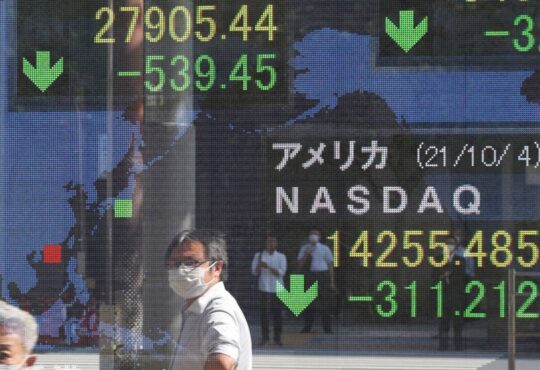
You know what they say: the first trillion dollars is the hardest.
No wait! They say it’s the first million dollars that’s hardest.
MILLION.
My apologies, but after looking at Apple’s business for a bit, your brain inflates every number it sees.
The statistics are mind-boggling.
Last year Apple boasted:
• $394 billion in revenues;
• 232 million iPhones sold;
• 1.3 billion iPhones in active use;
• 88 million subscribers to Apple Music.
If Apple were a country, then its revenues as a proxy for GDP would place it in the top 30 nations – somewhere between Norway and the UAE!
A world-conquering company
Incidentally, you may see Apple’s market cap compared to a country’s GDP.
But that’s gilding the lily.
It’s true that having just regained its $3 trillion market capitalisation, Apple’s valuation is now on a par with the UK’s total annual economic output.
But that’s to mistakingly compare stocks with flows.
Apple’s $3 trillion market cap is the value that investors put on owning its cashflows.
We simply don’t know what investors would pay to own the equivalent economic output of the UK.
Certainly the value of the UK stock market – which only includes a fraction of UK businesses – is no such thing.
But if you do hanker for a bit of national masochism, then this comparison provides it.
Because Apple’s market cap is now greater than the value of the whole UK stock market!
Yes, even if you owned and sold every last share of Shell, BP, HSBC, GSK, Unilever, and all the other firms listed in London, then you still wouldn’t have enough money to buy up Apple.
I warned you that the UK stock market was becoming a backwater.
But this is just ridiculous.
Growth supplements
Indeed, maybe it is ridiculous? Rather than feeding our national inferiority complex, perhaps we should consider that Apple might just be overvalued?
True, a lot of people have ended up looking foolish after making that call.
And Apple is now the biggest holding of Warren Buffett’s Berkshire Hathaway.
Betting against both Apple and Buffett would be… brave.
Nevertheless, with Apple having tripled in market cap since 2018, you wonder how the world’s largest company could grow similarly for another next five years?
Then again, perhaps it needn’t do so to satisfy shareholders. Thanks to buybacks and dividends, Apple stock has delivered a roughly 300% return over that period.
The difference between the market cap growth (200%) and shareholder return (300%) is thanks to smart capital allocation by management.
In theory Apple could continue to return its prodigious cashflows to shareholders like this and be a profitable investment, even if it is bumping up against the law of ginormous numbers with its $3 trillion valuation.
Only the paranoid survive
Can Apple management and its shareholders rest easy then?
I wouldn’t recommend it.
Like rust, technology – and capitalism – never sleeps.
Firstly, Apple is not being valued as a no-growth company. It’s on a P/E ratio of over 30. Its market cap would not be $3 trillion unless investors judged revenues and profits will continue to expand for years to come.
Moreover, everything we’ve seen during the past few decades makes it hard to imagine we’ll still be tapping away on apps on iPhones in 20 years’ time.
And if somehow we are?
Then for all the vaunted ‘locking in’ of its users, I don’t think Apple will still be earning the fat margins it enjoys today. Another two decades without a big platform shift would be enough time for rivals to compete away its profits.
Of course, as stewards of a company behind a good share of those technology revolutions since the 1970s, I’m sure Apple management is aware of these risks.
They’ll know Apple needs to keep inventing the future to ensure its place in it.
Which brings me to the recently unveiled Vision Pro – Apple’s first attempt since the iPhone to fundamentally transform how we interact with technology.
Open your eyes
Six weeks on from its unveiling – but still six months from launch – the verdict on Apple’s $3,499 Vision Pro ‘mixed reality’ headset is… mixed.
Sceptics carp the social cost of wearing what look like over-sized ski goggles is too high relative to the experiences on offer – be they virtual or augmented reality.
Worse, along with a high cost in social embarrassment, comes that gasp-inducing actual dollar cost, too.
You can augment your car, crib, or clothing with a lot of real reality for $3,499.
The other side sees Apple’s headset as a game-changer in Silicon Valley’s long trek to make fully immersive experiences about more than flight sims and porn.
For these Vision Pro visionaries, the headset’s inward-facing iris scanner and handset-free control system – as well as the innovative software to come from Apple’s army of software developers – renders comparisons with duds such as Google’s Glass and Meta’s Quest moot.
I can’t keep my eyes off of you
Personally, I believe both sides are right.
The thing is they are thinking on different timescales.
Of course “give it more time” is an excuse that’s been trotted out for virtual reality-style devices for at least three decades.
However if the demos are to believed, then the Vision Pro – which Apple calls a ‘spatial computer’ rather than a VR headset – already looks ready for primetime.
We’re all spending more time in front of screens and inside computer-mediated realities every day, whether it be with Zoom, games, or viral hits on TikTok.
And it’s inevitable we’ll keep looking for ways to better integrate our physical and digital worlds more seamlessly.
The snag with the Vision Pro is the price and that eternally goofy-looking hardware. Not that you wouldn’t want to own one.
Regarding the price, I always like to ask people who say they’ve no use for an innovative but expensive new gadget whether they’d think the same way if it cost half, a quarter – or even a tenth as much?
This usually reveals price shock is really the objection – not the product.
And that’s handy, because the march of technological progress has shown us new categories get vastly cheaper between early adoption and the mass-market.
I’m sure spatial computers – or whatever we call them – will be no different. Many people would love a Vision Pro at $499.
As for wearing a headset and gurning around your living room like a drunken robot from, well, 1984 – of course nobody buys a $3,499 headset to do that.
I can see for miles
Computer hardware enables software, and software enables experiences.
That’s what people buy – and use – these devices for.
Until the killer software arrives, the devices always look expensive and silly.
Consider smartphones. Almost nobody wanted to stare at screen the size of a few postage stamps until the iPhone arrived.
I should know – I’d co-founded a mobile games related start-up in 2005 and only the very nerdy (I’m allowed to say that, I was one) were interested before Apple got involved.
In fact it’s hard to remember how different things were 15 years ago.
One day I raced into the office to blurt out to my team that I’d seen no fewer than three people using iPhones in my tube carriage!
Nowadays, not being fixated on a screen during the commute would be a novelty.
There are myriad examples like this in tech history.
My dad worked in IT from the late 1960s yet he couldn’t see why he’d ever need a personal email in the early 1990s, whereas I already had one as a student.
It really never ends.
Provided we get the right software and experiences, I’m confident putting on a clunky headset will one day be as normal as doom-scrolling on your sofa is today.
I can see clearly now
Of course, none of this makes the Vision Pro a certain glimpse of the future.
Execution risk abounds.
But for $3 trillion Apple, the existential risk of not finding a bridge to tomorrow is far greater than the relatively modest R&D cost of trying out something new.
The first million-strong production run of the Vision Pro isn’t about profit for Apple.
It’s about trying to learn what needs to be done in order to keep that valuation in the trillions for many more years to come.





